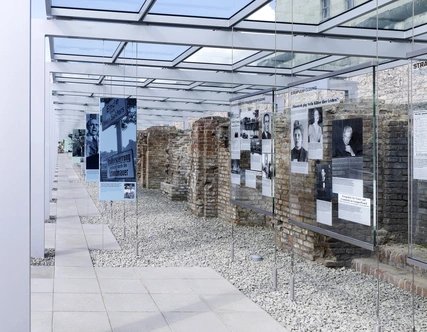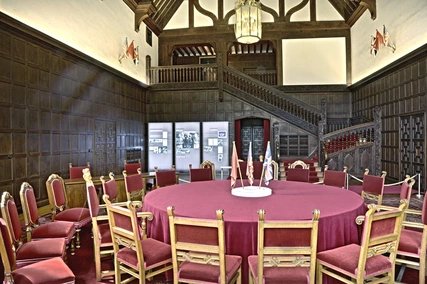
The end of the war in Berlin
Original historical sites bring history to life
Berlin, 8 May 1945, day of liberation. The city lies in ruins. A third of all homes and streets have been destroyed. The war is over, but it has left its mark.
Your app for the end of the war in Berlin
- Now available for free for iPhone and Android
- Learn more about Berlin's historical sites and memorials. Listen to how contemporary witnesses experienced the end of the Second World War. Learn more about that time, the unconditional surrender on 8 May, and the post-war years.


- On this bicycle route to 8 May 1945, you will pass numerous historical sites and memorials that bear witness to the time of the Second World War.
- On the occasion of the 75th anniversary, numerous memorial sites in Berlin are commemorating 8 May with special events, which is also a public holiday in Berlin in 2020.
Destroyed Berlin
In no other city has the past left as much of a mark as it has in Berlin. Although the former wastelands have been redeveloped and the rubble and ruins have disappeared, Berlin’s eventful history can still be found all over the cityscape.
If you walk through Berlin with your eyes peeled, you will wonder about the weird damage, craters and small, round holes in the walls and façades time and again. In fact, these are bullet holes from the Second World War.

In many places, such as on the façade of the Natural History Museum, the traces of the war have been deliberately preserved as reminders of the horrors of war. You can also discover bullet holes on the Victory Column, on the arches under the Friedrichstraße S-Bahn station and near Alexanderplatz, on the columns at the currently closed Pergamon Museum and the Bode Museum, as well as on the embankments of Museum Island.
The ruined tower, a plea for peace

The traces of the Battle of Berlin are unmissable on the statues of the Gropius Building, on the building of the Stiftung Neue Synagoge Berlin (New Synagogue Berlin Foundation) – and also on the tower of the Kaiser Wilhelm Memorial Church, probably the most striking memorial in Berlin.The church tower, destroyed by bombs, was preserved as a ruin after a public debate. A new building by the architect Egon Eiermann was later added to it.
You can also see the Stalingrad Madonna here. The charcoal drawing by the military hospital physician Kurt Reuber escaped the besieged city on a final transport plane during the Battle of Stalingrad. In 1983, relatives handed the picture over to the Memorial Church in remembrance of the victims. Another artwork exhibited in the church is the Coventry Cross, which serves as a reminder to maintain peace.
Inscriptions of Russian soldiers in the Reichstag
Im Reichstag finden Sie hinter einer schützenden Glasscheibe die Schriftzüge und Signaturen russischer Soldaten, die sich zwischen Mai 1945 und 1950 an den Wänden des von ihnen gestürmten Gebäudes verewigten.
Behind a protective pane of glass in the Reichstag, you will find the writings and signatures of Russian soldiers who, between May 1945 and 1950, immortalised themselves on the walls of the building they had stormed.
The surrender in Karlshorst
On 7 May, Colonel General Alfred Jodl signed the unconditional surrender of the Wehrmacht (German Army) at the Allied headquarters in Reims. On the night of 8–9 May, 1945, Wilhelm Keitel, Chief of the High Command of the Wehrmacht, signed the corresponding documents for the Soviet side in Berlin-Karlshorst.

You can still visit the hall in which the Germans surrendered in the former officers’ mess of the Wehrmacht pioneer school. From 1945 to 1949, this was the seat of the Soviet military administration in Germany. In 1967, the building became a historical memorial. Numerous original everyday objects, militaria, propaganda posters and field letters now give you an insight into the everyday life of soldiers and civilians on both sides.
Memorials and historical sites in Berlin
Es sind gemischte Erinnerungen, die wach werden. Erinnerungen, die schmerzen und nicht vergessen werden dürfen. Dokumentiert auch an zahlreichen authentischen Gedenkorten in Berlin, etwa der Topographie des Terrors (Bild unten), der ehemaligen Zentrale von Gestapo und der Reichsführung-SS. Das Haus der Wannsee-Konferenz, in dem sich die führenden Funktionäre des NS-Regierungsapparats sowie der SS über die "Endlösung" der sogenannten "Judenfrage" berieten, ist heute Museum und Bildungsstätte.

The Sachsenhausen concentration camp considers itself an open place of learning. Original sites dating from the time, barracks, cells and the administrative centre as well as several permanent exhibitions make history come alive.

Another place where world history was written in 1945 is Potsdam. Stalin resided in a villa here on Lake Griebnitz during the Potsdam Conference in the summer of 1945. At Cecilienhof Palace, the three main allies discussed the new European order – and the fate of Germany and the future division of the city.

Learn more about individual chapters of German history
- Nazi Government of the Reich (1933-1945) and the Second World War (1939-1945)
- Four Power Status and Reconstruction of Berlins (1945-1950s)
In the Allied Museum in Dahlem, you can learn more about the former American sector in the post-war period. In addition to original documents and film footage, you can also see the entrance to a British-American spy tunnel.

Auf dem Ehrenfriedhof im Treptower Park fanden 7000 Soldaten der sowjetischen Seite ihre letzte Ruhe. Das Sowjetische Ehrenmal Treptow ist ein beeindruckendes Monument, umrahmt von Wiesen und hohen Bäumen. Ein friedlicher Ort, der dazu einlädt inne zu halten. Der Krieg ist zu Ende.
7,000 Soviet soldiers found their final resting place in the Cemetery of Honour in Treptower Park. The Soviet War Memorial Berlin-Treptow is an impressive monument, surrounded by meadows and tall trees. A peaceful place that invites you to reflect. The war is over.
Other places against forgetting in today's Berlin
- Silent Heroes Memorial Center
- Memorial to the Murdered Jews of Europe
- Denkmal für die zur NS-Zeit verfolgten Homosexuellen
- Sinti and Roma Memorial
- Nazi Forced Labour Documentation Centre
- Memorial to the German Resistance
- Block of Women
- Soviet Memorial Tiergarten
- Neue Wache Memorial
- Rummelsburg Memorial
- New Synagogue Berlin Centrum Judaicum Foundation
- Book burning memorial at Bebelplatz